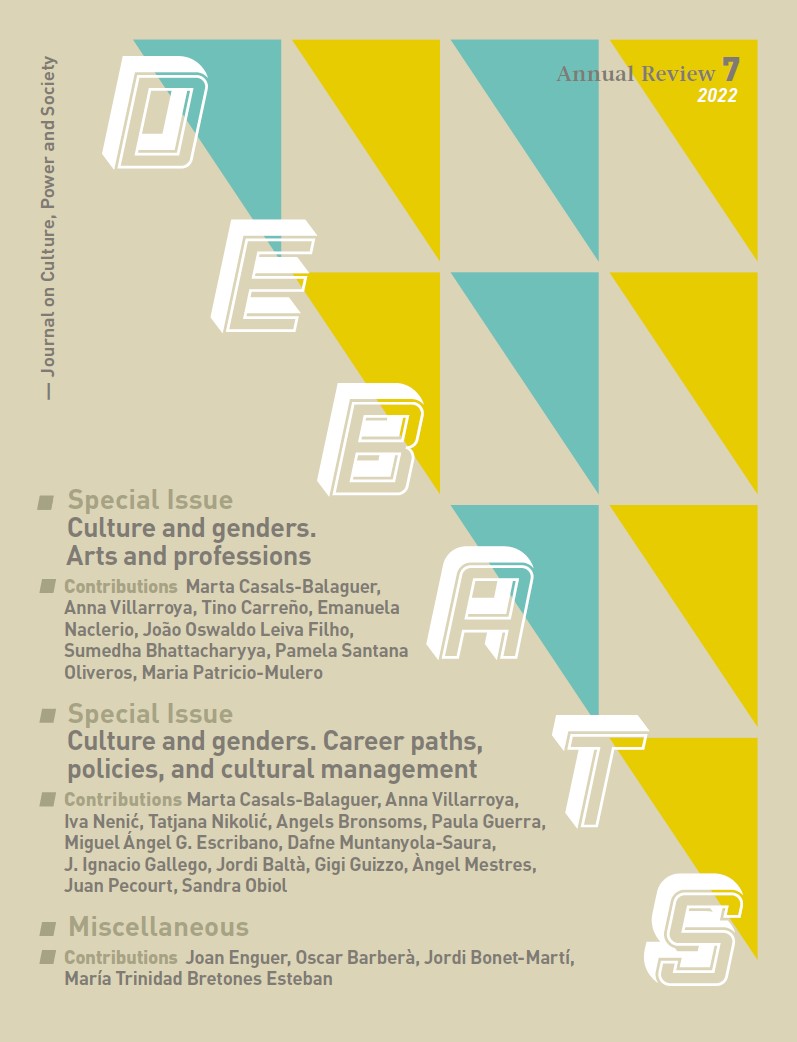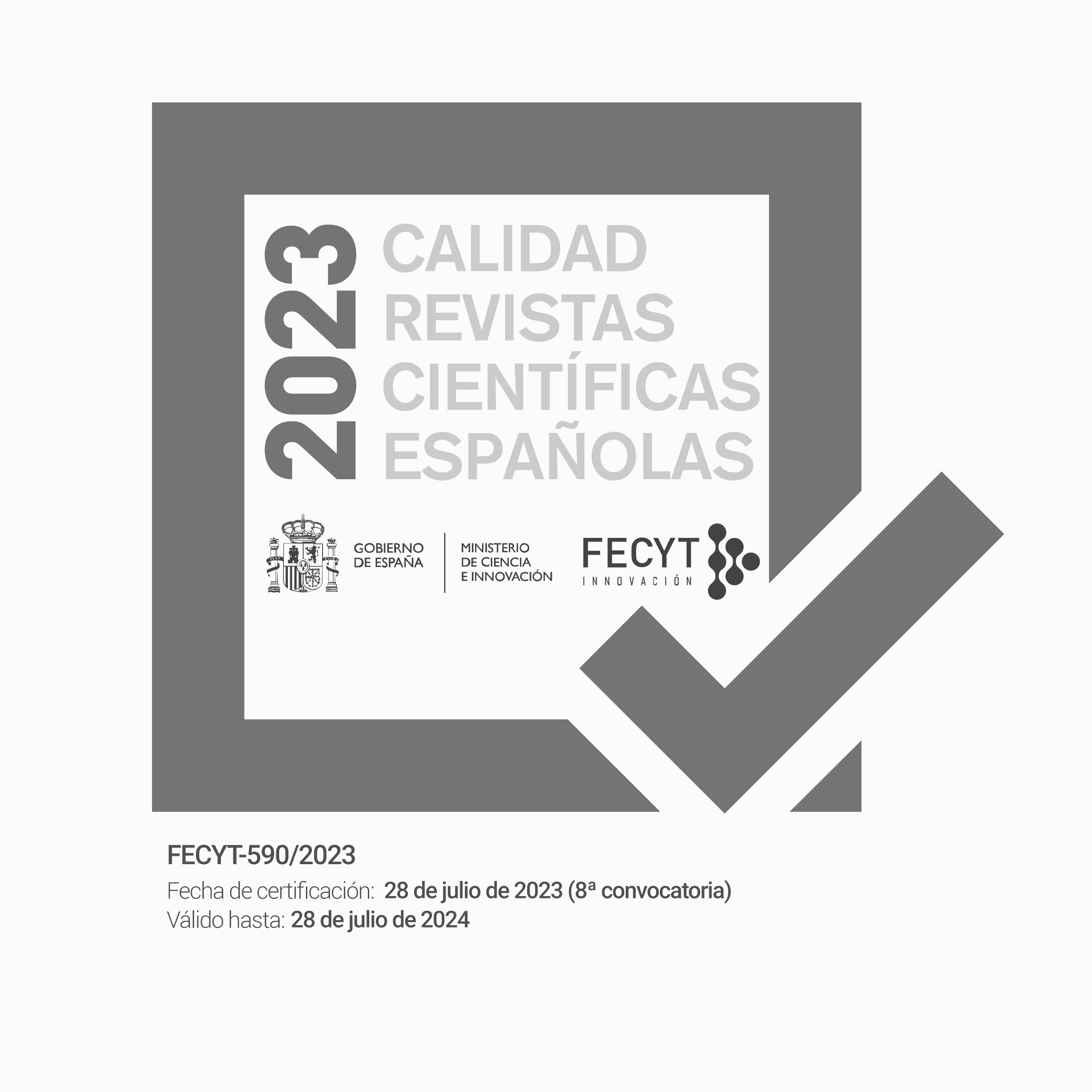Opposed devotions? Creation and care in the cultural precariat
Palabras clave:
creative labour, care work, free labour, gender, precarityResumen
In this article we will address the specific logic of cultural precariousness, focusing on gender factors that place working women in positions of structural weakness—a complex and multidimensional phenomenon. In our analysis, we focused on the relationship between creative labour and care work as differentiated social spaces. We understand ‘care work’ as the management of people’s well-being, essential for the sustainability of life and the reproduction of the workforce. On the other hand, ‘creative labour’ is the most visible dimension of artistic activity and implies the production of works that achieve a social value and are recognised as artistic. The latter includes, especially as a result of the recent precariousness processes at play, an important component of ‘free labour,’ individual background work aimed at providing adequate conditions for creation and which nowadays focuses on the construction and maintenance of social networks and e-reputation. In short, while creative labour constitutes the visible and socially recognised part of artistic practice, free labour and care work form the hidden part. Although these aspects do not receive social recognition, they largely determine individual achievements, beyond the romantic conceptions of the ‘genius artist’ strictly focused on the creative sphere. In our article we reflect on the relationship between both these types of work, construction of their constitutive logics—which are generally incompatible with each other—and identify their main contradictions.
Descargas
Citas
Abbing, H. (2002). Why are artists poor?: the exceptional economy of the arts. Amsterdam: Amsterdam University Press.
Aguado, A. (1998). Treball, gènere i identitat femenina a la societat valenciana contemporània. Cuadernos de Geografía,
,.325-337.
Ahlberg, J.; Roman, C.; Duncan, S. (2008). Actualizing the ‘Democratic Family’? Swedish Policy Rhetoric versus Family
Practices. Social Politics: International Studies in Gender, State & Society, 15 (1), 79-100. https://doi.org/10.1093/
sp/jxn003.
Andrejevic, M. (2009). Exploiting Youtube: contradictions of user-generated labour. En Snickars, P. y Vonderau, P.
(eds.). The Youtube reader. Estocolmo: National Library of Sweden (pp. 406-22).
Anllo Vento, F. (dir). (2020). I Informe sobre la aplicación de la Ley de Igualdad en el ámbito de la cultura dentro del marco
competencial del Ministerio de Cultura y Deporte: avance de la publicación. Observatorio de Igualdad de Género en
la Cultura. Acceso: http://www.culturaydeporte.gob.es/cultura/mc/espacio-de-igualdad/observatorio-igualdadgenero-
cultura/informes.html
Arthur, M.B. y Rousseau, D.M. (eds.) (1996). The boundaryless career. Nueva York y Oxford: OUP.
Asociación de Mujeres de la Industria de la Música (2020). Estudio de género en la industria de la música en España.
Recuperado de: https://asociacionmim.com/el-primer-estudio-de-genero-de-la-industria-musical-en-espana-arrojadatos-
desesperanzadores-para-las-mujeres-del-sector/ (Consulta: marzo 2021).
Babiano, J. (1993). Las peculiaridades del fordismo español. Cuadernos de Relaciones Laborales, 3, 77-94.
Badinter, E. (1991). ¿Existe el instinto maternal? Historia del amor maternal. Siglos XVII al XX Barcelona: Ediciones Paidós.
Bain, A. y McLean, H. (2013). “The artistic precariat”. Cambridge Journal of regions, economy and society, 6, 93-111.
Balbo, L. (1979). La doppia presenza. Inchiesta, 32,.3-6.
Banks, M. (2007). The politics of cultural work. Basingstoke: Palgrave MacMillan
Banks, M., y Milestone, K. (2011). Individualization, Gender and Cultural Work. Gender, Work & Organization, 18(1),
-89. https://doi.org/10.1111/j.1468-0432.2010.00535.x
Barbican (2018). In focus. Part of panic It’s an arts emergency. Londres, Barbican Center.
Beauvoir, S. de (2020) [1954]. Los mandarines. Barcelona: Edhasa.
Beck, U. y Beck-Gernsheim, E. (2003). La individualización. El individualismo institucionalizado y sus consecuencias
sociales y políticas. Barcelona: Paidós.
Bee, S.; Schor, M.; Chernick, M.; Shottenkirk, D.; Snyder, J.; Solomon, E.; Wilson, M.; Zucker, B. (2020). Sobre la
maternidad, el arte y la tarta de manzana (1992). Davey, M. (ed.) Maternidad y creación. Lecturas esenciales (pp.
-268). Barcelona: Alba Editorial.
Bolufer, M. (1995). La construcción de la identidad femenina: Reformismo e Ilustración. Estudis: Revista de historia
moderna, 249-265.
Bolufer, M. (2010). Madres, maternidad: Nuevas miradas desde la historiografía. Franco Rubio, G. (ed.) Debates sobre
la maternidad desde una perspectiva histórica (siglos XVI-XX) (pp. 51-81). Icaria.
Bolufer, M. (2013). Ciencia y moral. En los orígenes de la maternidad totalizante. Mètode. Popular Science Journal,
(76), 70-75. https://doi.org/10.7203/metode.76.2067
Bourdieu, P. (1999). La miseria del mundo. Buenos Aires: Fondo de Cultura Económica.
Bourdieu, P. (2000). La dominación masculina. Barcelona: Anagrama.
Bourdieu, P. (2013). Manet, une révolution symbolique. cours au collège de france (1998-2000) suivis d’un manuscrit
inachevé de pierre et marie-claire bourdieu. Paris: Seuil.
Bridges, L. E. (2018). Flexible as freedom? The dynamics of creative industry work and the case study of the editor
in publishing. New Media and Society, 20(4), 1303-1319. https://doi.org/10.1177/1461444816688920
Caves, R. (2002). Creative industries. Cambridge (MA): Harvard University Press.
Carrasco, C.; Borderías, C.; Torns, T.(eds) (2011). El trabajo de cuidados. Historia, teoría y políticas. Madrid. Los libros
de la Catarata.
Carrasco, C.; Recio, A. (2014). Del tiempo medido a los tiempos vividos. Revista de economía crítica, 17, 82-97.
Collins, R. (1998). The sociology of philosophies. A global theory of intellectual change. Cambridge (Mass): The Belknap
Press.
Comunian, R. y England, L. (2020). Creative and cultural work without filters: COVID19 and exposed precarity in
the creative economy. Cultural trends, 29 (2), 112-128. https://doi.org/10.1080/09548963.2020.1770577
Conor, B., Gill, R., & Taylor, S. (2015). Gender and creative labour. The Sociological Review, 63(S1), 1.
Crompton, R. (2006). Employment and the family: the reconfiguration of work and family life in contemporary societies.
New York: Cambridge University Press.
Crompton, R.; Brockmann, M; Lyonette, C. (2005). Attitudes, women’s employment and the domestic division of
labour: a cross-national analysis in two waves. Work, employment and society, vol. 19(2), 213–233.
Cubells, I. (2010). Los guionistas en la Comunidad Valenciana. Madrid: Fundación autor. Recuperado: http://ivac.
gva.es/banco/archivos/guionistas_valencia_pdf.pdf
Cuenca, S. (2020) LA REPRESENTATIVIDAD DE LAS MUJERES EN EL SECTOR CINEMATOGRÁFICO DEL LARGOMETRAJE
ESPAÑOL: 2019 CIMA. Recuperado: https://cimamujerescineastas.es/wp-content/uploads/2020/11/INFORME_
ANUAL_CIMA_2019.pdf
Daly, M. (2021). The concept of care: Insights, challenges and research avenues in COVID-19 times. Journal of
European Social Policy, 31(1), 108-118. https://doi.org/10.1177/0958928720973923
Daly, M.; Lewis, J. (2000). The concept of social care and the analysis of contemporary welfare states. The British
Journal of Sociology, 51(2), 281-298. https://doi.org/10.1111/j.1468-4446.2000.00281.x
Darnton, R. (2003). Edición y subversión. Literatura clandestina en el Antiguo Regimen. México: Buenos Aires.
De Peuter, G. (2014). Beyond the model worker: surveying a creative precariat. Culture Unbound, 6, 263-284.
Dent, T. (2020). Devalued women, valued men: Motherhood, class and neoliberal feminism in the creative media
industries. Media, Culture & Society, 42(4), 537-553. https://doi.org/10.1177/0163443719876537
Deresiewicz, W. (2021). La muerte del artista. Cómo los creadeores luchan por sobrevivir en la era de los billonarios y la
tecnología. Madrid: Capitán Swing.
Deuze, M. (2007). Media work. Cambridge: Polity Press.
Durán Heras, M.A. (1988). De puertas adentro. Madrid: Instituto de la Mujer.
Durán Heras, M.A. (2018). La riqueza invisible del cuidado. València: Universitat de València.
Elliott, S., Powell, R., & Brenton, J. (2015). Being a Good Mom: Low-Income, Black Single Mothers Negotiate Intensive
Mothering. Journal of Family Issues, 36(3), 351-370. https://doi.org/10.1177/0192513X13490279
Fabre, D. (1999). Le corps pathétique de l’écrivain. Gradhiva, 25, p. 1-13.
Florida, R. L. (2002). The rise of the creative class: And how it’s transforming work, leisure, community and everyday life.
New York: Basic Books.
Folbre, N. (2011). Medir los cuidados: género, empoderamiento y la economía de los cuidados Carrasco, C.; Borderías,
C.; Torns, T. (eds) (2011): El trabajo de cuidados. Historia, teoría y políticas. Los libros de la Catarata. Madrid.
Gálvez, L. (2013). Una lectura feminista del austericidio. Revista de economía crítica, 15, 80-110.
Gálvez, L.; Rodríguez-Modroño, P. (2016). Una crítica desde la economía feminista a la salida austericida de la
crisis. Atlánticas. Revista Internacional de Estudios Feministas, 1 (1), 8-33. doi: http://dx.doi.org/10.17979/
arief.2016.1.1.1346
Gladwell, M. (2000). The tipping point: how small things can make a big difference. Nueva York: Little, Brown and Company.
Gill, R. (2014). Unspeakable Inequalities: Post Feminism, Entrepreneurial Subjectivity, and the Repudiation of
Sexism among Cultural Workers. Social Politics: International Studies in Gender, State & Society, 21(4), 509-528.
https://doi.org/10.1093/sp/jxu016
Gillies, V. (2005): “Raising the ‘Meritocracy’: Parenting and the Individualization of Social Class”. Sociology, 39, 5,
-853. https://doi.org/10.1177/0038038505058368
González, M. J.; Jurado, T. (eds.). (2015). Padres y madres corresponsables. Una utopía real. Madrid: Los libros de la Catarata.
Handy, C. (1989). The age of unreason. Londres: Random House.
Harvey, A., & Shepherd, T. (2016). When passion isn’t enough: Gender, affect and credibility in digital games design.
International Journal of Cultural Studies, 20(5), 492-508. https://doi.org/10.1177/1367877916636140
Hays, S. (1998). Las contradicciones culturales de la maternidad. Paidós.
Heinich, N. (2003). “Femmes écrivains”. En Racine, N. y Trebitch, M., Intellectuelles. Du genre en histoire des intellectuels.
Bruselas: Complexe.
Hesmondhalgh D. y Baker, S. (2011). A very complicated version of freedom: conditions and experiences of creative
labour in three cultural industries. Poetics, 38, 4-20. https://doi.org/10.1016/j.poetic.2009.10.001
Hesmondhalgh, D., Baker, S. (2015). Sex, Gender and Work Segregation in the Cultural Industries. The Sociological
Review, 63(1_suppl), 23-36. https://doi.org/10.1111/1467-954X.12238
Iglesias de Ussel, J.; Meil, G. (2001) La política familiar en España. Barcelona: Ariel Ed.
Jones, D., & Pringle, J. K. (2015). Unmanageable Inequalities: Sexism in the Film Industry. The Sociological Review,
(1_suppl), 37-49. https://doi.org/10.1111/1467-954X.12239
Johnson, J. (1983). Minor characters: a beat memoir. Boston: Houghton Mifflin.
Le Guin, U.K. (1989). Dancing at the Edge of the World. Thoughts on Words, Women, Places. New York: Grove Press.
Lewis, J. (1992). Gender and the Development of Welfare Regimes. Journal of European Social Policy, 2(3), 159-173.
https://doi.org/10.1177/095892879200200301
Lewis, J. (2001) The Decline of the Male Breadwinner Model: Implications for Work and Care. Social Politics, 8 (2),
-169.
Louden, S. (2013). Living and sustaining a creative life. Chicago: The Chicago University Press.
Marwick, A. (2013). Status update: celebrity, publicity and branding in the social media age. Londres y New Haven: Yale
University Press.
McRobbie, A. (2002). Clubs to companies: notes on the decline of political culture in speeded up creative worlds.
Cultural studies, 16, 516-531. https://doi.org/10.1080/09502380210139098
Menger, P. (1991). Marché du travail artistique et socialisation du risque: Le cas des arts du spectacle. Revue Française
De Sociologie, 32(1), 61-74. doi:- 10.2307/3322356
Menger, P.M. (2006). Artistic labor markets:contingent work, excess supply and occupational risk management. En
Ginsburgh, V.A. y Throsby, D. (eds.), Handbook of economies of Art and Culture. (pp. 765-811).Elsevier.
Miège, B. (1989). The capitalization of cultural production. Nueva York: International General.
Morin, E. (1972). Les stars. Paris: Éditions du Seuil
Naldini, M. (2003). The family in the Mediteranean welfare states. London: Frank Cass.
Nash, M. (1996). Pronatalismo y maternidad en la España franquista. Bock, G. M; Thane, P. (eds.) Maternidad y políticas
de género. La mujer en los Estados de Bienestar europeos, 1880-1950. (pp. 279-308). Madrid: Cátedra.
Nash, M. (2010). Maternidad y construcción identitaria: Debates del siglo XX. Franco Rubio, G. (ed.) Debates sobre la
maternidad desde una perspectiva histórica (siglos XVI-XX) (pp. 23-50). Barcelona: Icaria.
Neff, G. (2002). Venture Labor: work and the Burden of Risk in Innovative Industries. Cambridge (MA): Cambridge University
Press.
Neilson, B. y Coté, M. (2014). “Introduction: are we all cultural workers now?”. Journal of cultural economy, 7 (1), pp. 2-11.
O’Brien, D. (2020). Culture is bad for you: inequality in the cultural and creative industries. Manchester: Manchester University
Press.
Obiol, S (2014) La transformación de la familia: el caso de los trabajadores del sector textil-confección valenciano.
Revista Española de Investigaciones Sociológicas (REIS), 145, 127-146
Obiol, S.; Castelló, R.; Verdeguer, I. (2016) Famílies monoparentals i treball remunerat: una anàlisi des del País Valencià.
Arxius de Sociologia, 34, 79-98
Percival, N. (2020). Gendered reasons for leaving a career in the UK TV industry. Media, Culture and Society, 42(3),
-430. Scopus. https://doi.org/10.1177/0163443719890533
Pérez Ibáñez, M., & López-Aparicio Pérez, I. (2019). Las artistas españolas y su actividad económica: Trabajo precario
en tiempos de crisis. Análisis y comparativa a partir de un estudio global. Debate Feminista, 59, 115-138. https://
doi.org/10.22201/cieg.2594066xe.2020.59.06
Pérez Orozco, A. (2006). Amenaza tormenta: la crisis de los cuidados y la reorganización del sistema económico. Revista
de economía crítica, 5, 7-37.
Pratt, A. C. (2002). Hot Jobs in Cool Places. The Material Cultures of New Media Product Spaces: The Case of South of the
Market, San Francisco. Information, Communication & Society, 5(1), 27-50. https://doi.org/10.1080/13691180110117640
Quemin, A. (2013). Les stars de l’art contemporain. notoriété et consécration artistiques dans les arts visuels. CNRS: Paris.
Ramón-Borja, M., Pastor, P., Sánchez. S., Sausor, M. (dir). (2020). ¿Dónde están las mujeres?: temporada 2018-19. Madrid:
Clásicas y Modernas. Recuperado: https://clasicasymodernas.org/2a-edicion-donde-estan-las-mujeres-en-lasartes-
escenicas/
Rius-Ulldemolins, J. y Pecourt, J. (2021). La sociología de la cultura en la era digital. Valencia: PUV.
Saraceno, C. (1995). Familismo ambivalente y clientelismo categórico en el Estado de Bienestar italiano. Sarasa, S.;
Moreno, L. (comp.) El Estado del Bienestar en la Europa del Sur. vol 7. (pp.261-88). Madrid: CSIC.
Sennett, Richard (2000) La corrosión del carácter. Las consecuencias personales del trabajo en el nuevo capitalismo. Barcelona:
Anagrama.
Sennett, Richard (2006) The Culture of the New Capitalism. New Haven&London: Yale University Press.
Standing, Guy (2013). El precariado. Una nueva clase social. Barcelona: Pasado y Presente.
Trifiletti, Rosana (1999). Southern European Welfare Regimes and the Worsening Position of Women. Journal of European
Social Policy, vol.9(1), 49-64. doi:10.1177/095892879900900103
Tasset, C et al. (2013). Livres ou prolétarisés? Les travailleurs intellectuels précaires en Ile-deFrance. Paris: Centre D’Etudes
de l’Emploi.
Terranova, T. (2004). Network culture. Londres: Pluto Press.
Zafra, Remedios (2017). El entusiasmo. Barcelona: Anagrama.
Descargas
Publicado
Cómo citar
Número
Sección
Licencia
Sin perjuicio de lo dispuesto en el artículo 52 de la Ley 22/1987 de 11 de noviembre de Propiedad Intelectual, BOE del 17 de noviembre de 1987, y conforme al mismo, los autores o autoras ceden a título gratuito sus derechos de edición, publicación, distribución y venta sobre el artículo, para que sea publicado en Debats. Revista de cultura, poder y sociedad.
Debats. Revista de cultura, poder y sociedad se publica bajo el sistema de licencias Creative Commons según la modalidad «Reconocimiento - NoComercial (by-nc): Se permite la generación de obras derivadas siempre que no se haga un uso comercial. Tampoco se puede utilizar la obra original con finalidades comerciales».
Así, cuando el autor o autora envía su colaboración, acepta explícitamente esta cesión de derechos de edición y de publicación. Igualmente autoriza a Debats. Revista de cultura, poder y sociedad, la inclusión de su trabajo en un fascículo de la revista para que se pueda distribuir y vender.











